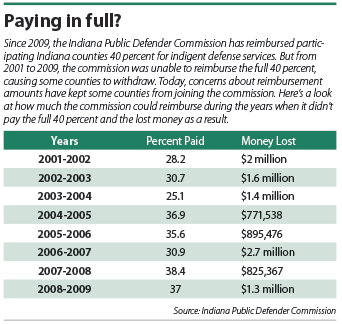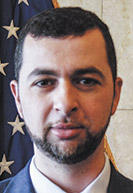Subscriber Benefit
As a subscriber you can listen to articles at work, in the car, or while you work out. Subscribe NowAs the number of children in need of services cases continues to rise, public defenders across Indiana are stretching themselves to be able to offer competent representation while also serving as many clients as possible. Defenders are likewise feeling a strain on their misdemeanor caseloads as they try to walk the tightrope of serving every client while finding enough funding to keep in compliance with caseload maximums.
 At the second meeting of the Interim Study Committee on Courts and the Judiciary on Sept. 21, public defenders from around the state gathered to express their concerns about the difficulty of maintaining caseload requirements and offered suggestions on ways to infuse more money into the public defender system when the state budget has already been set for the next two years. That funding could enable some counties to join the Indiana Public Defender Commission, a membership they have thus far evaded due to their inability to hire enough staff to keep in compliance with the commission’s mandatory caseload maximums, Larry Landis, executive director of the Indiana Public Defender Council, told the committee.
At the second meeting of the Interim Study Committee on Courts and the Judiciary on Sept. 21, public defenders from around the state gathered to express their concerns about the difficulty of maintaining caseload requirements and offered suggestions on ways to infuse more money into the public defender system when the state budget has already been set for the next two years. That funding could enable some counties to join the Indiana Public Defender Commission, a membership they have thus far evaded due to their inability to hire enough staff to keep in compliance with the commission’s mandatory caseload maximums, Larry Landis, executive director of the Indiana Public Defender Council, told the committee.
 Landis
LandisIn his presentation to committee members, Landis pointed to three main reasons public defenders are struggling to keep up with the demand on their offices. First, he noted that the commission does not provide reimbursement for misdemeanor cases, which has led to serious issues concerning excessive caseloads. Some counties, such as Allen, have even faced federal litigation as a result of their caseload issues, he said.
 Hill
HillIn regard to CHINS cases, Landis noted the widespread opioid epidemic is a well-known factor that is causing the sharp increase in CHINS litigation, as well as in termination of parental rights cases that frequently follow a CHINS adjudication. At the Marion County Public Defender Agency, the CHINS department has doubled in staff size since 2013, while the CHINS caseload has increased by 104 percent, Marion County Chief Public Defender Robert Hill told the committee. The TPR caseload has likewise increased by 139 percent, Hill said.
But Landis and Hill also noted the state’s decision to take over funding of the Department of Child Services has placed an undue burden on the counties. When DCS funding shifted to the state, the responsibility of providing indigent defense to parents whose children are alleged to be CHINS was left to county public defenders, but no additional funding was built in to fulfill that responsibility, Landis said. Further, though an additional $1 million was added to the current biennial budget for CHINS cases, there is no mechanism to disburse that money to the counties, Hill said.
Virginia Lawrence, a supervisor in the CHINS division at the Marion County Public Defender Agency, told the committee that she and her colleagues have felt the strain of the increase in their caseloads. Not only are they in court much more often than they were before, but CHINS litigators are also now struggling to find enough time to meet with their clients and get to know them on a more personal level, Lawrence said.
“A few years ago, I used to know my clients, I could recognize their faces, I knew their moms’ names, what was going on with their case,” Lawrence said. “And it’s just not that way anymore.”
 Qaddoura
QaddouraTo that end, Fady Qaddoura, Indianapolis-Marion County controller, told the committee the issue surrounding CHINS caseloads is a family issue, as families are directly impacted when their representation is spread too thin. And from an economic perspective, Qaddoura said his office has had to work with the Indianapolis City-County Council outside of the normal budget process on almost a quarterly basis to add more than $250,000 per quarter to add an additional team consisting of three lawyers, a social worker and paralegal in the Marion County Public Defender Agency.
Though membership in the Public Defender Commission gives counties access to 40 percent reimbursement for indigent defense services if public defenders’ offices maintain certain caseload maximums, some counties have chosen not to join because they cannot afford to maintain those maximums, Landis said. On a similar note, Larry Hesson, a Hendricks County attorney who offered testimony on behalf of the Association of Indiana Counties, said Hendricks County recently joined the commission and will likely have to spend more money to maintain compliance with caseload guidelines.
Further, from 2001 to 2009, the commission was unable to reimburse the full 40 percent requested from the counties for their indigent defense services for felonies. That resulted in prorating and led to the loss of as much as $2.7 million due to prorated reimbursement, according to data Landis provided to the committee. From 2003 to 2004, the commission was only able to reimburse 25.1 percent of the total requests — the lowest reimbursement rate in the data Landis provided — leading to a loss of $1.4 million.
As a result, participating counties began to view the commission’s requirements as an unfunded mandate and, thus, left the commission based on their belief that the state was an unreliable funding partner. Today, 33 counties are not participating in the commission’s reimbursement program, an issue Landis attributed, in part, to the commission’s historical inability to provide the full reimbursement.
To remedy that issue, Landis set forth a proposal that would add language to existing law to allow the State Budget Agency to authorize augmentation of the Public Defense Fund. If there was authorization to supplement the fund through augmentation and counties did not have to supplement reimbursement, then more counties would likely join the commission and maintain the applicable caseload requirements, he said.
On the issue of misdemeanor case-loads, Landis pointed to commission data that show counties miss out on roughly $1.9 million each quarter in reimbursement funds for misdemeanor cases, or a total of almost $8 million annually. However, about $9 million in non-reverting funds have accumulated in the Public Defense Fund, he said.
If the Legislature would remove statutory language that prohibits the commission from reimbursing misdemeanors and instead allow the commission to use the $9 million for that reimbursement, it could begin to cover the $8 million in non-reimbursed funds, Landis said. Those funds would then go into each county’s general fund, where they could be allocated based on the county’s most pressing needs. That need could be either CHINS cases or compliance with misdemeanor caseloads, whichever is more urgent, he said.
Hill agreed the state is “woefully behind” on its funding for misdemeanor defenders and called on the General Assembly to find a way to reimburse public defenders for handling those cases. He also called on lawmakers to increase the reimbursement rate for CHINS and TPR cases to 50 percent, while maintaining the 40 percent level for all other cases.
The final meeting of the Interim Committee on Courts and the Judiciary is scheduled for Oct. 5, when a final report will be adopted.•
Please enable JavaScript to view this content.
